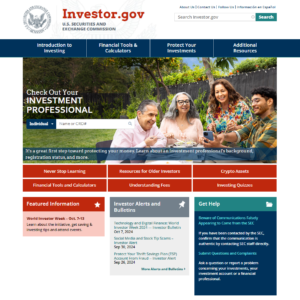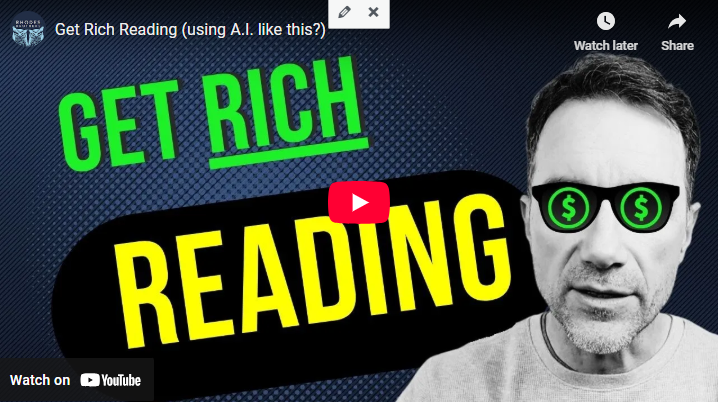For More Free Videos, Subscribe to the Rhodes Brothers YouTube Channel.
Waking up to the comforting scent of freshly brewed coffee every day, and knowing it’s yours to enjoy endlessly, might sound like a fantasy. But hold on tight—you’re about to dive into a transformative journey that will completely reshape how you think about money, investing, and the powerful potential of passive income.

In a recent video, John S. Rhodes of the Rhodes Brothers dropped a mathematical bombshell that’s been causing quite a stir in the financial community. He revealed a simple yet profound calculation that shows just how much money you’d need to invest to enjoy free coffee for life. But this isn’t just about coffee – it’s about understanding the fundamentals of financial freedom and the incredible potential of passive income.
As John puts it, “This should unlock brand new universe in your mind in so many ways. It shows you the power of having money set aside that can actually generate that much money.” So, are you ready to have your mind blown and discover the secrets to financial independence? Let’s dive in!
TL;DR
- $5 daily coffee costs $1,825 annually
- You need $36,500 invested at 5% interest to generate $5 daily
- This revelation highlights the power and challenges of passive income
- Alternative strategies like side hustles can be more accessible
- Compound interest and early investing are crucial for long-term wealth
- Creating passive income streams can be more efficient than pure savings
The $36,500 Coffee Conundrum
When John S. Rhodes of the Rhodes Brothers dropped this mathematical bombshell, it sent ripples through the financial community. Let’s dive deeper into this eye-opening calculation:
- Daily coffee cost: $5
- Annual coffee expense: $5 x 365 days = $1,825
- Required investment at 5% return: $36,500
The Math Behind the Magic
To truly grasp why you need $36,500, let’s break down the math:
- 5% of $36,500 = $1,825 (annual return)
- $1,825 ÷ 365 days = $5 per day
This simple calculation reveals a profound truth about passive income and investing. It’s not just about the daily cup of joe; it’s about understanding the relationship between capital, returns, and sustainable income.
Tools to Calculate Your Own “Coffee Number”

- Compound Interest Calculator: Use online tools like the one provided by Investor.gov to calculate how much you need to invest for your desired passive income.
- Personal Capital: This free financial tool can help you track your investments and see how close you are to your “coffee number” goal.
- Excel or Google Sheets: Create your own spreadsheet to play with different scenarios and investment amounts.
What This Means for Your Financial Future
The coffee example is just the tip of the iceberg. Let’s explore what this revelation means for your broader financial goals:
- The Power of Compound Interest: Starting early and letting your investments grow over time can lead to significant wealth accumulation. Albert Einstein reportedly called compound interest the “eighth wonder of the world.”
- The Challenge of Passive Income: Generating meaningful passive income requires a substantial initial investment. This highlights the importance of starting early and being consistent with your savings and investments.
- The Importance of Yield: Even a small difference in yield (say, 3% vs. 5%) can have a massive impact on the capital required to generate your desired income. This underscores the importance of choosing the right investments and minimizing fees.
- The Reality Check: For many, saving $36,500 might seem daunting, highlighting the need for alternative strategies and a long-term perspective.
Tools for Understanding and Leveraging Compound Interest
- Rule of 72 Calculator: This simple tool helps you quickly estimate how long it will take for your investment to double.
- Compound Interest Visualizer: Websites like VisualizeWealth.com offer interactive graphs to help you visualize the power of compound interest over time.
- Retirement Calculators: Tools like those offered by Vanguard or Fidelity can help you see how compound interest affects your long-term retirement savings.
Alternative Paths to Financial Freedom
While the $36,500 coffee fund might seem out of reach, don’t despair! There are other ways to achieve your financial goals:
Side Hustles and Passive Income Streams
As John suggests, “This is one reason why I absolutely love the idea of publishing a book… If that book only gets me one sale per day or two sales per day, then that’s equivalent to $36,000.”
Examples of side hustles:
- Self-publishing e-books
- Creating online courses
- Starting a dropshipping business
- Developing a niche blog or YouTube channel
- Affiliate marketing
- Renting out a spare room on Airbnb
- Creating and selling digital products (e.g., templates, printables, software)
Tools for Side Hustles
- Amazon Kindle Direct Publishing: For self-publishing e-books
- Teachable or Udemy: For creating and selling online courses
- Shopify: For setting up an e-commerce store
- WordPress: For creating a blog or website
- Canva: For designing digital products and marketing materials
- ConvertKit: For email marketing to promote your side hustle
Skill Development and Career Growth
Investing in your skills and career can lead to higher income, making it easier to save and invest:
- Pursue additional certifications or degrees
- Network and seek mentorship opportunities
- Negotiate for raises or promotions
- Consider changing jobs for better compensation
Tools for Skill Development and Career Growth
- LinkedIn Learning: For professional development courses
- Coursera: For university-level courses and certifications
- Glassdoor: For researching salaries and company reviews
- Indeed: For job searching and career research
- Meetup: For networking events in your industry
Mindful Spending and Budgeting
Sometimes, the path to financial freedom starts with optimizing your current spending:
- Use budgeting apps like YNAB or Mint to track expenses
- Implement the 50/30/20 rule (50% needs, 30% wants, 20% savings)
- Look for areas to cut unnecessary expenses
- Consider cheaper alternatives to daily luxuries
Tools for Mindful Spending and Budgeting
- YNAB (You Need A Budget): For zero-based budgeting
- Mint: For tracking expenses and creating budgets
- Trim: For identifying and canceling unnecessary subscriptions
- Ibotta: For earning cashback on everyday purchases
- Rakuten: For cashback on online shopping
The Compound Effect
Every dollar you save and invest brings you closer to your goals. As the famous investor Warren Buffett once said, “Someone’s sitting in the shade today because someone planted a tree a long time ago.”
This quote perfectly encapsulates the power of long-term thinking and consistent action. Here’s how you can apply this wisdom:
- Start Early: Even small investments can grow significantly over time.
- Be Consistent: Regular contributions to your investment portfolio add up.
- Reinvest Returns: Let your earnings generate more earnings through compounding.
- Diversify: Spread your investments to manage risk and potentially increase returns.
Tools for Implementing the Compound Effect
- Acorns: For automatically investing spare change
- M1 Finance: For setting up automated investment plans
- Betterment: For goal-based investing with automatic rebalancing
- Vanguard: For low-cost index fund investing
- Fidelity: For a wide range of investment options and research tools
Leveraging Technology for Financial Success
In today’s digital age, numerous tools can help you on your journey to financial freedom:
- Robo-Advisors: Platforms like Betterment or Wealthfront offer low-cost, automated investing.
- Micro-Investing Apps: Acorns and Stash allow you to invest small amounts regularly.
- Personal Finance Software: Tools like Personal Capital help you track your net worth and investments.
- Online Learning Platforms: Websites like Coursera or Udemy offer courses on investing and financial management.
Advanced Tools for Financial Analysis
- TradingView: For technical analysis and stock charting
- Morningstar: For in-depth investment research and analysis
- Finviz: For stock screening and market visualization
- Yahoo Finance: For real-time stock quotes and financial news
- Seeking Alpha: For investment ideas and analysis from a community of investors
The Psychology of Wealth Building
Understanding the numbers is crucial, but mastering the mental game is equally important:
- Delayed Gratification: Cultivate the ability to forgo immediate pleasures for long-term gains.
- Growth Mindset: Believe in your ability to learn and improve your financial situation.
- Resilience: Be prepared for market fluctuations and setbacks in your financial journey.
- Goal Setting: Set clear, achievable financial milestones to keep yourself motivated.
Tools for Cultivating a Wealth-Building Mindset
- Headspace: For mindfulness and meditation to reduce financial stress
- Habitica: For gamifying your financial goals and habits
- Stickk: For creating commitment contracts to stick to your financial goals
- Coach.me: For finding accountability partners and coaches for your financial journey
- Goodreads: For discovering and tracking books on personal finance and wealth-building
Creating a Diversified Investment Portfolio
While the coffee example focuses on a 5% return, it’s crucial to understand the importance of diversification:
- Stocks: For long-term growth potential
- Bonds: For stability and income
- Real Estate: For potential passive income and appreciation
- Index Funds: For broad market exposure at low costs
- Alternative Investments: For further diversification (e.g., precious metals, cryptocurrencies)
Tools for Building a Diversified Portfolio
- Wealthfront: For automated portfolio management with tax-loss harvesting
- Fundrise: For investing in real estate investment trusts (REITs)
- Robinhood: For commission-free stock and ETF trading
- Coinbase: For cryptocurrency investing
- TD Ameritrade: For access to a wide range of investment products and research tools
Tax Optimization Strategies
Don’t forget about the impact of taxes on your investment returns:
- Utilize tax-advantaged accounts like 401(k)s and IRAs
- Consider Roth conversions for tax-free growth
- Implement tax-loss harvesting to offset gains
- Be mindful of holding periods for more favorable long-term capital gains rates
Tools for Tax Optimization
- TurboTax: For preparing and filing your taxes
- H&R Block Tax Calculator: For estimating your tax liability
- Taxact: For affordable tax preparation and planning
- Credit Karma Tax: For free tax filing
- TaxBit: For cryptocurrency tax reporting
By leveraging these strategies, tools, and mindsets, you’re well on your way to creating your own “free coffee forever” fund and achieving broader financial freedom. Stay consistent, keep learning, and don’t be afraid to adjust your strategies as you grow and your circumstances change.
Actionable Steps
College Students
- Calculate Your “Textbook Number”
- Start a campus-based tutoring side hustle
- Set up small automatic savings transfers
- Join a finance club or take a personal finance course
- Use Mint to track spending and saving
Young Professionals (25-35)
- Calculate Your “Rent Number”
- Create a professional blog or YouTube channel
- Automate 401(k) and Roth IRA contributions
- Read “The Simple Path to Wealth” by J.L. Collins
- Use Personal Capital to monitor investments
Mid-Career Professionals (35-50)
- Calculate Your “Mortgage Number”
- Offer freelance consulting services
- Increase 401(k) contributions and index fund investments
- Attend a financial planning seminar
- Use YNAB for comprehensive budgeting
Pre-Retirees (50-65)
- Calculate Your “Healthcare Number”
- Write an e-book based on career expertise
- Max out catch-up contributions to retirement accounts
- Take a retirement planning course
- Use Vanguard’s retirement calculator
Parents with Young Children
- Calculate Your “Childcare Number”
- Create and sell parenting-related printables
- Set up automatic 529 plan contributions
- Read “The MoneySmart Family System”
- Use FamZoo to manage family finances
Common Mistakes to Avoid
Start Small, Start Now
- Solution: Set up automatic monthly investments, even if it’s just $25.
- Tool: Use micro-investing apps like Acorns or Stash.
Minimize Fees
- Solution: Choose low-cost index funds or ETFs.
- Tool: Compare fund expenses using Morningstar’s Fee Analyzer.
Focus on Steady Growth
- Solution: Adopt a long-term investment strategy.
- Tool: Use a compound interest calculator to visualize steady growth.
Diversify Wisely
- Solution: Invest in a mix of stocks, bonds, and other assets.
- Tool: Consider robo-advisors like Betterment for automated diversification.
Account for Inflation
- Solution: Aim for returns that outpace inflation.
- Tool: Use an inflation calculator to understand its impact on your savings.
Frequently Asked Questions
How can I start investing with little money?
Begin with micro-investing apps like Acorns or use fractional share investing through platforms like Robinhood. Even small, regular investments can grow significantly over time.
Is it better to pay off debt or start investing?
Generally, it’s advisable to pay off high-interest debt (like credit cards) before investing. However, you might consider doing both if you have low-interest debt and can benefit from employer 401(k) matching.
How much should I be saving for retirement?
A common rule of thumb is to save 15% of your income for retirement. However, this can vary based on your age, lifestyle, and retirement goals. Use online retirement calculators for a more personalized estimate.
What’s the difference between active and passive investing?
Active investing involves trying to beat the market through frequent trading and portfolio management. Passive investing aims to match market performance through index funds or ETFs, typically with lower fees and less frequent trading.
How can I create multiple streams of income?
Consider options like rental property income, dividend-paying stocks, creating digital products, freelancing, or starting an online business. Diversifying your income sources can provide financial stability and growth opportunities.
What’s the best way to learn about investing?
Start with reputable books like “The Intelligent Investor” by Benjamin Graham or “A Random Walk Down Wall Street” by Burton Malkiel. Online courses, financial blogs, and podcasts are also excellent resources for continuous learning.
How do I know if I’m on track with my financial goals?
Regularly review your net worth, savings rate, and progress towards specific goals. Tools like Personal Capital or Mint can help you track these metrics. Consider consulting with a financial advisor for personalized guidance.
What’s the role of risk tolerance in investing?
Your risk tolerance determines the types of investments suitable for you. It’s influenced by factors like your age, financial goals, and personal comfort with market fluctuations. A higher risk tolerance might lead to a more aggressive, growth-oriented portfolio, while a lower risk tolerance might suggest a more conservative approach.
How can I protect my investments from market downturns?
Diversification across different asset classes, geographic regions, and sectors can help mitigate risk. Additionally, maintaining an emergency fund and having a long-term perspective can help you weather market volatility.
What tax considerations should I be aware of when investing?
Different investment accounts have various tax implications. For example, traditional IRAs offer tax-deferred growth, while Roth IRAs provide tax-free withdrawals in retirement. Consider consulting with a tax professional to optimize your investment strategy for tax efficiency.
Your Journey to Financial Freedom Starts Now
As we’ve explored in this deep dive into the world of passive income and investing, the path to financial freedom might seem daunting at first glance. The “$36,500 coffee fund” revelation by John S. Rhodes serves as both a wake-up call and an inspiration. It shows us the power of passive income while also highlighting the need for strategic thinking and alternative approaches to wealth building.
Financial freedom isn’t just about having enough money for daily luxuries like coffee. It’s about creating a life where you have the freedom to make choices based on what truly matters to you, not just on what you can afford. Whether through traditional investing, side hustles, skill development, or a combination of strategies, the key is to start now and remain consistent.
As you embark on this journey, keep in mind that every small step counts. Every dollar saved, every skill learned, and every passive income stream created brings you closer to your goals. The road may be long, but with patience, perseverance, and the right strategies, you can achieve the financial freedom you desire.
For more insightful content and the latest videos to help you succeed in your financial journey, be sure to check out and subscribe to the Rhodes Brothers YouTube Channel. Your future self will thank you for taking action today!
Resource List
Books
- “Rich Dad Poor Dad” by Robert Kiyosaki
- “The Simple Path to Wealth” by JL Collins
- “The Millionaire Fastlane” by M.J. DeMarco
- “The 4-Hour Work Week” by Timothy Ferriss
- “Your Money or Your Life” by Vicki Robin and Joe Dominguez
Podcasts
- “ChooseFI” – Financial Independence podcast
- “BiggerPockets Money” – Personal finance and wealth-building strategies
- “Smart Passive Income” with Pat Flynn
- “Afford Anything” with Paula Pant
- “The Side Hustle Show” with Nick Loper
Courses
Tools and Apps
- Personal Capital – For tracking net worth and investments
- YNAB (You Need A Budget) – For budgeting and expense tracking
- Robinhood – For commission-free stock trading
- Acorns – For micro-investing and rounding up purchases
- Mint – For comprehensive financial management
- Betterment – Robo-advisor for automated investing
- Credit Karma – For credit score monitoring and improvement
- Shopify – For setting up an e-commerce side hustle
- Canva – For creating designs for digital products or marketing materials
- Teachable – For creating and selling online courses
Blogs and Websites
- Mr. Money Mustache – Early retirement and financial independence
- The Simple Dollar – Practical personal finance advice
- Nerdwallet – Financial product comparisons and advice
- Investopedia – Comprehensive financial education resource
- Bogleheads – Forum for index fund investing discussions
YouTube Channels
- Graham Stephan – Personal finance and real estate investing
- The Financial Diet – Lifestyle and money management
- Andrei Jikh – Cryptocurrency and personal finance
- Minority Mindset – Entrepreneurship and investing
Professional Services
- Vanguard Personal Advisor Services – For personalized financial planning
- H&R Block – For tax preparation and advice
- LegalZoom – For setting up business entities for side hustles
- Upwork – For finding freelance work or hiring freelancers for your projects
- Fiverr – For offering or purchasing small business services
Remember, the key to success is not just accessing these resources, but actively engaging with them and applying the knowledge to your unique financial situation. Happy learning and investing!



